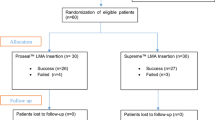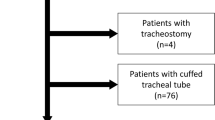Abstract
Purpose
Nowadays the size of the streamlined liner of the pharynx airway (SLIPA™) is selected by matching the width of the thyroid cartilage of the patient to the widest dimension of the SLIPA™. The objective of this work was to improve the method of selection by matching the distance between the otobasion inferius and the most inferior margin of the cricoid cartilage (O–C) to the length of the SLIPA™ chamber.
Methods
100 patients (ASAI–II) scheduled to undergo operations under general anesthesia were randomly divided into two groups, group A (size selected by matching O–C with SLIPA™ chamber length, n = 50) and group B (size selected by matching the width of the thyroid cartilage with the widest dimension of the SLIPA™, n = 50). We measured the distance between the nasopharynx and the interarytenoid fold (N–I) and investigated the correlation between O–C and N–I at the neutral head position. Number of attempts, insertion time, blood on the device, leakage, and the need to change sizes were assessed.
Results
A positive correlation (r = 0.68, p < 0.05) was detected between N–I and O–C. Leakage was observed in 6 % (n = 3) of group A patients and in 20 % (n = 10) of group B patients (p < 0.05).
Conclusion
Compared with the classic size-selection method, matching the width of the thyroid cartilage with that of the SLIPA™, the size-selection method of matching SLIPA™ chamber length to O–C for adult patients is more accurate.




Similar content being viewed by others
References
Miller DM, Lavelle M. A streamlined pharynx airway liner: a pilot study in 22 patients in controlled and spontaneous ventilation. Anesth Analg. 2002;94:759–61.
Miller DM, Light D. Laboratory and clinical comparisons of the streamlined liner of the pharynx airway (SLIPA™) with the laryngeal mask airway. Anesthesia. 2003;58:136–42.
Miller DM, Camporota L. Advantages of ProSeal™ and SLIPA™ over tracheal tubes for gynecological laparoscopies. Can J Anesth. 2006;53(2):188–93.
Miller DM. A proposed classification and scoring system for supraglottic sealing airways: a brief review. Anesth Analg. 2004;99:1553–9.
Lange M, Smul T, Zimmermann P, Kohlenberger R, Roewer N, Kehl F. The effectiveness and patient comfort of the novel streamlined pharynx airway liner (SLIPA) compared with the conventional laryngeal mask airway in ophthalmic surgery. Anesth Analg. 2007;104(2):431–4.
Spitzer VM, Whitlock DG. National Library of Medicine (U.S.). Part I original images. In: Transverse atlas of the visible human male: reverse engineering of the human body. Sudbury: Jones and Bartlett Publishers, Inc.; 1998. p. 28–31.
Moeller TB, Reif E. Neck-axial. In: Pocket atlas of sectional anatomy—CT and MRI—vol 1. Head and neck. New York: Thieme New York; 2007. p. 166–7.
Jiang SX, Ma SS. Head and neck. In: Atlas of sectional anatomy correlated with MRI CT and ECT. Shen Yang: Liaoning Science and Technology Publishing House; 2006, p. 26–7.
Greenland KB, Edwards MJ, Hutton NJ. External auditory meatus–sternal notch relationship in adults in the sniffing position: a magnetic resonance imaging study. Br J Anaesth. 2010;104(2):268–9.
Rice MJ, Mancuso AA, Gibbs C, Morey TE, Gravenstein NL, Deitte LA. Cricoid pressure results in compression of the postcricoid hypopharynx: the esophageal position is irrelevant. Anesth Analg. 2009;109(5):1546–52.
Schmalfuss IM, Mancuso AA, Tart RP. Postcricoid region and cervical esophagus: Normal appearance at CT and MRI. Radiology. 2000;214:237–46.
Asoh R, Goyal RK. Manometry and electromyography of the upper esophageal sphincter in the opossum. Gastroenterology. 1978;74:514–20.
Goyal RK, Cobb, BW .Motility of the pharynx, esophagus and esophageal sphincters. In: Johnson LR, editor, translator and editor. Physiology of the Gastrointestinal Tract. New York: Raven Press, 1981;359–91.
Singh S, Hamdy S. The upper oesophageal sphincter. Neurogastroenterol Motil. 2005;17(Suppl. 1):3–12.
Samman N, Mohammadi H, Xia J. Cephalometric norms for the upper airway in a healthy Hong Kong Chinese population. Hong Kong Med. 2003;9(1):25–30.
Conflict of interest
None.
Author information
Authors and Affiliations
Corresponding author
About this article
Cite this article
Li, Y., Xie, Y. & Wei, X. A novel method for SLIPA™ size selection, for adult patients, on the basis of chamber length. J Anesth 27, 557–562 (2013). https://doi.org/10.1007/s00540-013-1571-2
Received:
Accepted:
Published:
Issue Date:
DOI: https://doi.org/10.1007/s00540-013-1571-2




